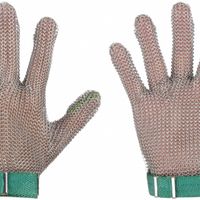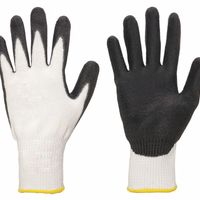Call +(254) 703 030 000 / 751 483 999 / 721 704 777
- Home
- Safety
- Hand Arm Protection
- Safety Gloves
- Cut Resistant Gloves
.....Read More
Frequently Asked Questions
What are cut-resistant gloves used for?
Cut-resistant gloves are designed to protect hands from injuries caused by sharp objects such as knives, glass, or metal. They are commonly used in industries where workers handle materials that pose a risk of cuts, lacerations, or punctures. These gloves are made from high-performance materials like Kevlar, Dyneema, or stainless steel mesh, which provide varying levels of protection based on the specific needs of the task.
In the food industry, cut-resistant gloves are essential for chefs and kitchen staff who frequently use sharp knives and slicers. In construction and manufacturing, workers use these gloves when handling metal sheets, glass, or other sharp-edged materials. They are also crucial in the automotive and aerospace industries, where precision and safety are paramount.
Cut-resistant gloves are categorized by levels of protection, often rated by standards such as ANSI/ISEA or EN388. These ratings help users select the appropriate gloves based on the severity of the hazards they face. The gloves are designed to offer a balance between protection and dexterity, ensuring that users can perform tasks efficiently without compromising safety.
In addition to industrial applications, cut-resistant gloves are used in recreational activities like fishing, hunting, and woodworking, where there is a risk of cuts. They are also employed in law enforcement and military settings for protection against sharp weapons.
Overall, cut-resistant gloves are a critical component of personal protective equipment (PPE), helping to reduce the risk of hand injuries, improve workplace safety, and enhance productivity by allowing workers to handle sharp objects with confidence.
How do cut-resistant gloves work?
Cut-resistant gloves work by incorporating materials and construction techniques designed to resist cuts and abrasions. These gloves are made from high-performance fibers such as Kevlar, Dyneema, or Spectra, which have high tensile strength and are inherently cut-resistant. Some gloves also use stainless steel or glass fibers woven into the fabric to enhance protection.
The effectiveness of cut-resistant gloves is measured by their cut resistance level, often rated according to standards like ANSI/ISEA or EN 388. These standards assess the glove's ability to withstand cutting forces, with higher levels indicating greater protection.
The gloves are designed with a tight weave or knit pattern, which helps to distribute the force of a sharp object over a larger area, reducing the likelihood of penetration. Additionally, the materials used can have a slippery surface, causing blades to slide off rather than cut through.
Some gloves also feature multiple layers, combining different materials to enhance protection while maintaining flexibility and dexterity. This layering can absorb and dissipate the energy from a cutting motion, further preventing injury.
Overall, cut-resistant gloves provide a balance between protection, comfort, and functionality, allowing users to handle sharp objects safely in various industrial and domestic settings.
What materials are cut-resistant gloves made from?
Cut-resistant gloves are made from a variety of materials designed to provide protection against cuts and lacerations. These materials include:
1. **Kevlar**: A synthetic fiber known for its high tensile strength and heat resistance. It is lightweight and offers excellent cut resistance, making it a popular choice for gloves used in industrial settings.
2. **Dyneema**: Also known as ultra-high-molecular-weight polyethylene (UHMWPE), Dyneema is extremely strong and lightweight. It provides high cut resistance and is often used in gloves for its durability and comfort.
3. **Spectra**: Similar to Dyneema, Spectra is another form of UHMWPE. It offers high cut resistance and is often used in combination with other materials to enhance glove performance.
4. **Stainless Steel Mesh**: Used in chainmail gloves, stainless steel mesh provides excellent cut and puncture resistance. These gloves are often used in food processing and meatpacking industries.
5. **HPPE (High-Performance Polyethylene)**: This material is known for its strength and cut resistance. It is often blended with other fibers to enhance the protective qualities of gloves.
6. **Fiberglass**: Often used in combination with other fibers, fiberglass adds strength and cut resistance to gloves. It is typically used in environments where high levels of protection are required.
7. **Basalt Fiber**: Made from volcanic rock, basalt fiber is strong and resistant to cuts. It is sometimes used in combination with other materials to improve glove performance.
8. **Composite Yarns**: These are blends of various fibers, such as Kevlar, Dyneema, and fiberglass, to create gloves that offer enhanced cut resistance and comfort.
These materials are often combined in various ways to create gloves that meet specific safety standards and requirements for different industries.
How do I choose the right cut-resistant gloves?
To choose the right cut-resistant gloves, consider the following factors:
1. **Identify the Hazard Level**: Assess the level of cut risk in your work environment. Use the ANSI/ISEA or EN 388 standards to determine the required cut resistance level. ANSI levels range from A1 (light protection) to A9 (heavy protection), while EN 388 levels range from 1 to 5.
2. **Material**: Choose the appropriate material based on the task. Common materials include:
- **Kevlar**: Offers good cut resistance and heat protection.
- **Dyneema**: Lightweight with high cut resistance and comfort.
- **HPPE (High-Performance Polyethylene)**: Provides excellent cut resistance and durability.
- **Metal Mesh**: Best for high-risk environments like meat processing.
3. **Grip and Dexterity**: Ensure the gloves provide a good grip and allow for dexterity. Coatings like nitrile, polyurethane, or latex can enhance grip, especially in wet or oily conditions.
4. **Comfort and Fit**: Select gloves that fit well and are comfortable for extended wear. Consider breathability and flexibility to reduce hand fatigue.
5. **Additional Protection**: If needed, look for gloves with added features like impact protection, puncture resistance, or thermal insulation.
6. **Compliance and Certification**: Ensure the gloves meet industry standards and certifications for cut resistance.
7. **Cost and Durability**: Balance cost with durability. Higher initial costs may be justified by longer-lasting gloves.
8. **Trial and Feedback**: Test different gloves in your work environment and gather feedback from users to ensure they meet safety and comfort needs.
By considering these factors, you can select the right cut-resistant gloves that provide optimal protection and functionality for your specific needs.
Are leather gloves cut-resistant?
Leather gloves are not inherently cut-resistant. While leather is a durable material that offers some degree of protection against abrasions and minor cuts, it does not provide the specialized protection required to prevent cuts from sharp objects. The cut resistance of gloves is determined by the material's ability to withstand cutting forces, which is measured by standards such as the ANSI/ISEA 105 or EN 388.
Leather gloves may offer some basic protection in low-risk environments, but for tasks involving sharp tools or materials, gloves made from cut-resistant materials like Kevlar, Dyneema, or metal mesh are recommended. These materials are specifically engineered to resist cutting and provide higher levels of protection.
In summary, while leather gloves can offer some protection, they are not suitable for tasks requiring high cut resistance. For such tasks, gloves made from specialized cut-resistant materials should be used.
What is the difference between knit and leather cut-resistant gloves?
Knit cut-resistant gloves are made from high-performance fibers such as Kevlar, Dyneema, or HPPE (High-Performance Polyethylene). These fibers are woven or knitted into a fabric that provides flexibility, breathability, and comfort. The knit structure allows for dexterity and tactile sensitivity, making them suitable for tasks requiring precision. They often incorporate additional coatings, like nitrile or polyurethane, to enhance grip and abrasion resistance. Knit gloves are generally lightweight and can be designed to offer varying levels of cut resistance, depending on the thickness and type of fibers used.
Leather cut-resistant gloves, on the other hand, are made from natural or synthetic leather materials, often combined with cut-resistant liners. The leather provides durability, abrasion resistance, and a degree of puncture protection. These gloves are typically heavier and less flexible than knit gloves but offer superior protection against cuts and punctures in heavy-duty applications. Leather gloves are often used in industries like construction, metalworking, and welding, where robust protection is necessary.
In summary, knit gloves offer flexibility, comfort, and dexterity, making them ideal for precision tasks, while leather gloves provide enhanced durability and protection for more demanding environments. The choice between the two depends on the specific requirements of the task, such as the level of cut resistance needed, the importance of dexterity, and the working conditions.
How do I maintain and clean cut-resistant gloves?
To maintain and clean cut-resistant gloves, follow these steps:
1. **Read Manufacturer's Instructions**: Always start by checking the care label or manufacturer's instructions for specific cleaning guidelines.
2. **Pre-Cleaning Inspection**: Before washing, inspect the gloves for any damage or wear. Replace gloves if they are compromised.
3. **Remove Debris**: Shake off loose dirt and debris. Use a soft brush to remove stubborn particles.
4. **Washing**:
- **Machine Wash**: If allowed, use a gentle cycle with cold or warm water. Avoid hot water as it can degrade the material.
- **Hand Wash**: Use mild detergent and lukewarm water. Gently scrub the gloves to remove dirt.
5. **Detergent**: Use a mild, non-bleach detergent. Avoid fabric softeners as they can reduce the gloves' cut resistance.
6. **Rinsing**: Rinse thoroughly to remove all detergent residues, which can cause skin irritation or degrade the glove material.
7. **Drying**:
- **Air Dry**: Lay the gloves flat or hang them to air dry. Avoid direct sunlight or high heat sources.
- **Machine Dry**: If permitted, use a low-heat setting. High heat can damage the fibers.
8. **Post-Cleaning Inspection**: After drying, inspect the gloves again for any signs of damage or wear.
9. **Storage**: Store gloves in a clean, dry place away from direct sunlight and chemicals. Avoid folding or compressing them to maintain their shape and integrity.
10. **Regular Maintenance**: Regularly clean and inspect gloves to ensure they remain effective and safe for use.
By following these steps, you can extend the lifespan of your cut-resistant gloves and maintain their protective qualities.



